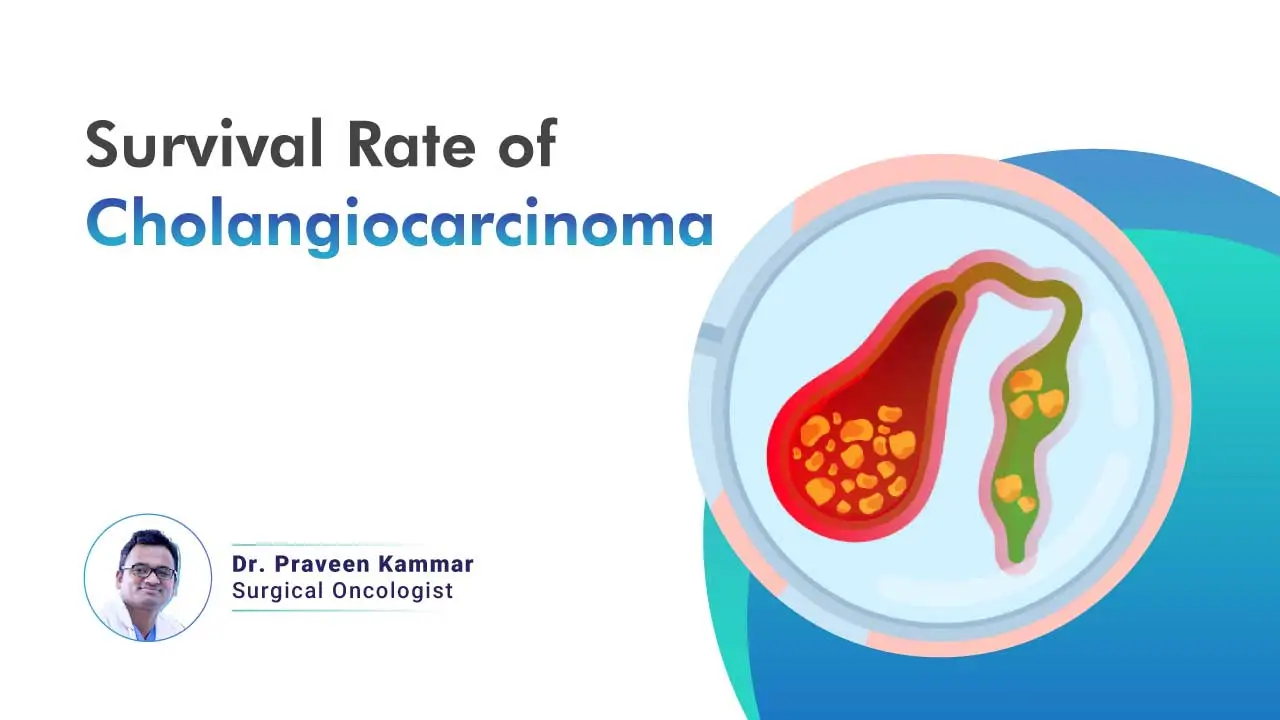Cholangiocarcinoma: Survival Rates and Treatment Impact
As a dedicated surgical oncologist with a deep commitment to helping patients navigate the often complex world of cancer diagnosis and treatment, we’re tackling a lesser-known but equally important topic – cholangiocarcinoma. This type of cancer, which originates in the bile ducts, can seem intimidating and overwhelming.
However, I firmly believe that knowledge is our most powerful tool when facing any health challenge. We’ll delve into what cholangiocarcinoma is, how it progresses, the survival rates at each stage, and the impact of various treatments. I aim to provide you with valuable information to help you or your loved ones on this journey.

What is Cholangiocarcinoma?
Cholangiocarcinoma, also known as bile duct cancer, is a serious condition that isn’t as widely recognized as other forms of cancer. It arises in the bile ducts – small, tube-like structures responsible for transporting bile from your liver to your small intestine. Bile plays a crucial role in our digestion process, as it helps break down fats and remove waste products from our bodies.
There are several types of cholangiocarcinoma, each named according to its location within the biliary system: intrahepatic, perihilar, and distal cholangiocarcinoma. The causes of this disease remain somewhat elusive, but certain risk factors have been identified, including primary sclerosing cholangitis, chronic liver disease, and specific liver infections.
Symptoms often include jaundice, abdominal pain, and unexplained weight loss. Diagnosing cholangiocarcinoma usually involves a combination of imaging tests, lab tests, and sometimes, a biopsy.
Stages of Cholangiocarcinoma & Survival Rates
Once diagnosed, cholangiocarcinoma is classified into stages from Stage 0, where the disease is localized to the innermost layers of bile ducts, to Stage IV, where it has spread to distant organs. Each stage carries a different prognosis and survival rate.
Early-stage cholangiocarcinoma (Stage 0 and I) typically has the highest survival rates because surgical removal is often possible. However, as the disease progresses to stages II and III, it invades deeper into the surrounding tissues and organs, making surgical removal more complex and impacting survival rates.
Stage IV cholangiocarcinoma, which represents advanced disease, often carries lower survival rates. However, even at this stage, treatment can help manage symptoms and improve quality of life.
When compared to other cancers, the survival rates of cholangiocarcinoma are very low. For bile duct cancers outside the liver, the 5-year survival rate is 17% for localized disease and 16% for disease with spread to nodes. When the disease has spread to other organs ( stage 4 ) the survival at 5 years is a mere 2%.
Also Read: How Rare is Cholangiocarcinoma?
Deciphering Survival Rates
Survival rates are essentially statistical tools that provide an overview of the percentage of people who survive a specific type of cancer for a certain period after their diagnosis.
For cholangiocarcinoma, survival rates depend on numerous factors, including the stage at diagnosis, the patient’s overall health, and how well the cancer responds to treatment.
While survival rates give us an understanding of the general prognosis, they don’t tell the full story. Every individual’s journey with cholangiocarcinoma is unique, and survival rates can’t predict individual outcomes. Nonetheless, they can offer a glimpse into what one might expect.
Impact of Treatment on Survival Rates
Surgery, when feasible, offers the best chance for a cure, especially when the cancer is localized. Chemotherapy and radiation therapy can be used in conjunction with surgery or as standalone treatments in advanced cases.
Targeted therapies and immunotherapy, newer forms of treatment that work by specifically attacking cancer cells, have shown promise in improving survival rates.
A multidisciplinary approach, which involves combining different types of treatments, often yields the best results. It’s like assembling a puzzle – each piece (or treatment) plays a vital role in completing the picture (or improving patient outcomes).
An aggressive and comprehensive treatment is the only hope for improving survival in cholangiocarcinoma.
Need more help to plan treatment? Call Us.
Dr. Praveen Kammar, is renowned cancer surgeon with 12+ years of experience & has done 6000+ surgeries till date.
The Journey Beyond Survival
Surviving cholangiocarcinoma isn’t just about living beyond the disease; it’s also about maintaining a good quality of life post-treatment. This involves managing side effects from treatment, staying emotionally resilient, and having a robust support system.
Regular follow-ups with your oncologist, supportive care, and lifestyle modifications can all contribute to a positive long-term outlook.
The Future of Cholangiocarcinoma Treatment
While treating cholangiocarcinoma presents certain challenges, the future is indeed promising. Ongoing research and clinical trials globally are exploring innovative therapies and technologies.
These advancements could potentially revolutionize cholangiocarcinoma treatment, offering improved survival rates and better quality of life for patients.
Conclusion
A diagnosis of cholangiocarcinoma may initially seem insurmountable, but armed with knowledge and medical advances, you’re never alone in this journey. By understanding the disease, its stages, survival rates, and treatment options, you’re equipped to face this challenge head-on.
As a surgical oncologist, I’m here to guide you at every step, offering advanced care. Remember, every journey begins with a single step. Let’s take this step together towards understanding and managing cholangiocarcinoma.

About Author
Dr. Praveen Kammar
Surgical Oncologist
12+
Years Of Experience
Dr. Praveen Kammar is a Best Surgical Oncologist in Mumbai. His main area of expertise aslso includes GI oncology, Gynecological cancers, minimal access surgeries, Robotics surgery, Laparoscopic Surgery, HIPEC.
Dr. Praveen has done more than 6000+ surgeries in his expertise.
Related Blogs
How Rare is Cholangiocarcinoma?
Bile duct cancer, or Cholangiocarcinoma, begins in the cells lining the bile ducts, distinguishing it as a distinct form of cancer
Why is Cholangiocarcinoma So Deadly?
Cholangiocarcinoma is highly deadly because of its aggressive nature. It is a rare but deadly form of cancer that originates in the bile ducts
Can Cholangiocarcinoma (bile duct cancer) be Cured?
Cholangiocarcinoma treatment sees hope in targeted therapies, which selectively target cancer cells based on genetic traits, deviating from the non-specific impact of chemotherapy & radiation


